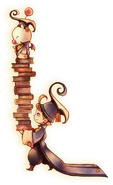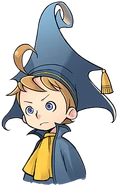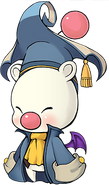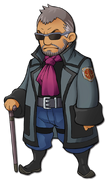Template:Sideicon
Template:Infobox CVG Final Fantasy Record Keeper is a free-to-play social role-playing game where players participate in memorable battles from the Final Fantasy series.
Gameplay
The player assembles a party of up to five members consisting of the main character, Tyro (the default name is Tyro, but can be changed at the beginning) as well as various named and generic Final Fantasy characters[1]. With their party, the player visits the various worlds of the main Final Fantasy series, and progresses through the game by completing Classic Dungeons recreated from the Record Realm that they are set in. While in a dungeon, the player cannot change party members, equipment, or set abilities. Each dungeon consists of one or more locations, which have one or more Active Time Battles. These battles use pixel art sprites against a 2D background, with sprites being taken from the 2D games in the series, reused from Final Fantasy All the Bravest, or being created fresh in a retro style for the game. Uniquely for the sideline game, Final Fantasy Record Keeper has animated boss and summon sprites.
The battles in a location are fought consecutively, with HP, Status effects (including: Paralyze, Confuse, Sleep, Poison, Petrify, Silence and Blind), and abilities used from each battle carrying over to the next. Once all battles in a location are completed, the player is given a score for that location—"Novice", "Expert", or "Champion" ("Normal", "Good", or "Excellent" in Japanese)—based on time taken, damage received, player characters dead, and Target Score(s) (スペシャルスコア, Supesharu Sukoa?) for any bosses that were fought. If the player receives an Expert score for the location, they are given 150% of the party's accumulated EXP (resulting in a battle worth 200 EXP being worth 300), while a Champion score for a location awards a "Champion Bonus!!" of 200% EXP (a battle worth 200 EXP is instead worth 400). Battles can be fought manually or automatically, which can be changed throughout the battle. If auto-battle is being used, characters will only attack, they will not use Soul Break abilities, magic or defend.
Each location has a Stamina (スタミナ, Sutamina?) cost to challenge it. The player's Stamina gauge starts out at 30/30 points. Used Stamina points regenerate at a rate of one point per three minutes of real time. The player's maximum Stamina can be increased by collecting Stamina Shards (スタミナのかけら, Sutamina no Kakera?), with every five shards increasing the maximum Stamina by one point, and in most cases, also fully restoring Stamina.
Once all locations within a dungeon have been completed, the player receives a rank of Bronze, Silver or Gold. If Gold is achieved then that dungeon is considered Mastered (マスター, Masutā?). Special First Time Rewards are given for completions and masteries, which can include Stamina Shards, Mythril, equipment, abilities, orbs, new party members, and unlocking further realms and dungeons. In addition, clearing a dungeon has a Gil reward given each time.
Players may revisit previously completed dungeons at any time and complete them again and again, paying the associated Stamina cost each time, in order to level grind and farm items. Furthermore, mastering a dungeon unlocks a higher level version of the same dungeon known as an Elite Dungeon (フォースダンジョン, Fōsu Danjon?, lit. Force Dungeon). Elite Dungeons have much higher Stamina costs, but they yield higher level orbs and have their own separate completion and mastery rewards.
In addition to the normal realms that are always available, the game also has Events (イベント, Ibento?) which are only available for a limited time. Events usually reward players with characters unavailable by other means. Previous events have been re-run months later, providing another opportunity to acquire those characters. There is also a different daily event for each day of the week. There is a limit on how often events may be challenged.
While the game is free to play, there is a real money cash shop where currency can be exchanged for Gems (モグコイン, Mogu Koin?, lit. Mog Coin). Gems may in turn be used to pay for anything that Mythril can be used for. Conversion rates are as follows: 97 Gems per unit of currency in Japan, 100 Gems per US$0.99 or equivalent in other territories.
Mythril can be used for the following:
- Resting in a Camp between dungeons, restoring HP, status, and used abilities.
- Continuing in a dungeon when the party has been wiped out. This restores the party to full strength as resting does, gives them a random temporary stat bonus, and returns them to the beginning of the location to try again.
- Instantly regaining all Stamina.
- Relic Draw (装備召喚, Soubi Shoukan?, lit. Equipment Summon), a lottery that awards equipment of varying power and rarity.
- Increasing the inventory limit for equipment and the inventory limit for abilities, both of which start at 100 slots.
Rarity
Abilities, orbs, Growth Eggs, refining items, weapons, armor, and accessories are rated from one star ☆ to six stars ☆☆☆☆☆☆. This functions as a power rating of sorts; for example, Thunder is ☆ while Thundaga is ☆☆☆. Abilities require orbs of the same rarity to synthesize. Growth Eggs bestow more EXP when used the more stars they have. Equipment of higher rarity has higher stats than equipment of lower rarity. Naturally, the higher rarity items drop less frequently than lower rarity items off monsters of the same level. The highest-ranked abilities require materials from Ultimate dungeons and the Nightmare campaign, available at the end of each month.
Equipment upgrades
Each character may equip one weapon, one piece of armor, and one accessory at a time. Weapons and armor may be leveled up via a refinement process carried out by Cid. This costs gil and requires the sacrifice of another piece of equipment. Once the item's level gauge is filled, it levels up and its stats improve. Filling the gauge requires more raw material the higher the level is to be achieved. The item's level limit is based on its rarity, with ☆ equipment having a maximum level of three and ☆☆☆☆☆ equipment having a maximum level of twenty. In addition to using up other pieces of equipment, players may also use Adamantite or Scarletite. Adamantite is better for leveling up armor and scarletite is better for leveling up weapons. Higher rarity refining materials add more to the item's leveling gauge.
Weapons and armor at their maximum levels may be upgraded, gaining a star and a "+" after its name. Thus for example a Battleaxe (★) may be upgraded to a Battleaxe+ (★★). This costs gil and an additional copy of the item to be upgraded. Thus, the player can be faced with a dilemma when an additional piece of hard-to-get equipment is acquired: use it to upgrade their original piece, or use it as equipment? Any given weapon or armor may be upgraded twice.
Ability synthesis and upgrades
Each character has slots to equip up to two abilities at a time. Orbs (オーブ, ōbu?) dropped off monsters are used to synthesize abilities. This synthesis is carried out by Cid for a fee in gil. Abilities have a limited number of uses per dungeon, which may be increased four times by Cid at a cost in orbs and gil. In order to synthesize Summoning Magic abilities, Summoning Orbs (召喚のオーブ, Shoukan no ōbu?) are required, which are only obtained through events.
Soul Breaks
Soul Breaks are Limit Break-like abilities unique to each character that may be used in battle. Soul Breaks consume from one up to the maximum possible three units of the Soul Gauge. By default, every party member has only one individual Soul Break. However, some rare weapons and armor contain additional Soul Breaks that can either be used only by specific party members, or are shared by any party member able to wear that piece of equipment. Party members wearing such gear may choose up to three additional Soul Breaks to use for battle.
Series origin
Characters, weapons, armor, and accessories can be categorized by their series origin (シリーズ, Shirīzu?, lit. Series). This is a roman style numeral denoting their game of origin (for example, "VII" for Final Fantasy VII) or a small crystal icon (the English word "Job" in Japanese) for generic characters and Tyro. Characters battling in their home realm are surrounded by a blue aura of power and receive a substantial boost in stats in battle and earn more EXP, this is called "Record Synergy". Equipment worn in battles in its world of origin has its icon border turn blue and also receives a substantial power up.
It is often worthwhile to use equipment that matches the realm the player will be fighting in, even if it would be weaker otherwise. Because new dungeons are released on a regular basis, and new dungeons can be located in any of the worlds, there is an incentive to stockpile a variety of gear in each origin.
Breaking level caps
Initially, the level limit for characters is 50, but breaking level caps (限界突破, Genkai Toppa?) may be performed to raise this limit by finding a character's Memory Crystal (記憶結晶, Kioku Kesshou?) and using it to break that character's level cap. It should be noted, however, that not all party members may have Memory Crystals available to them. These crystals are usually earned through completing one of the Elite dungeons in the event that the character in question is related to (note that this does not necessarily mean having obtained said character in the same event). Characters who break their initial level cap can rise to a level of 65.
Starting with the October 2015 backend update of Final Fantasy Record Keeper, many Series Heroes are able to break the second level cap with a Memory Crystal II to reach a third level cap of 80.
Both types of Memory Crystals can only be collected once per character per player ID, such that further attempts to acquire the same level Crystal that is already in the player's possession or has been applied will convert subsequent Crystals into Growth Eggs.
Record Materia
Characters whose initial level cap has been broken can equip Record Materia. Record Materia grant useful effects in battle for that party member. While many Record Materia are obtained by specific characters under specific conditions, many can also be equipped by all characters whose level caps have been broken. Many bonuses may also overlap or repeat as well.
Quests and missions
Quests
Through February 17, 2016, players could choose to undertake a Quest at any time they were in the Main Hall by going to the Main Hall screen, pressing the Quest button, and selecting a quest from the quest menu. Each quest had its own reward and its own requirement that must be completed—for example, to clear a certain dungeon. Many of the quests were of a tutorial nature and had requirements such as leveling up a weapon or synthesizing a certain ability. Once the quest was complete, the player then had to go to the Item Chest (プレゼントBOX, Purezento BOX?, lit. Present Box) on the main menu to receive their reward. Up to five quests could be queued at a time.
There were 176 quests when the system was retired, which included several Bonus Quests among them. These Bonus Quests awarded a new character (or a Growth Egg if the player already had that character). Bonus Quest characters were Cecil (as both a Dark Knight and a Paladin), Tellah, Edward, Lenna, Krile, Gilgamesh, Terra, Edgar, Sabin, Cyan, Shadow, Celes, Setzer, Mog, Zack, Barret, Tifa, Aerith, Sephiroth, Rinoa, Quistis, Selphie, Garnet, Eiko, Amarant, Tidus, Yuna, Lulu, Auron, Lightning, Sazh, and Vanille.
Missions
Since the February 18, 2016 backend update, a portion of the simpler Quests has been transitioned into Cid's Missions. Cid now carries sets of mission orders from his lab, requiring only that players check his postboard for new missions to complete. When actions performed by the player match assigned mission orders, the mission is flagged "Complete" and the player can go back to the postboard to collect the mission's reward.
Roaming Warrior
Players can designate a party member as a Roaming Warrior who can be summoned by friends or other players in battle, where they will appear to unleash a Soul Break. The power of the Soul Break depends on the Roaming Warrior's stats. This allows players limited access to Soul Breaks for characters that they may not normally have access to, as well as open up battles to strategic uses of Roaming Warriors to aid them in battle.
Players may pick from a list of Roaming Warriors of other players whom they follow, or from strangers who happen to be online at the time. Players also receive a nominal fee of 200 gil for each time their Roaming Warriors are summoned per day.
Setting
Tyro is tasked by Dr. Mog to stop the darkness from corrupting the stories and memories sealed within magical paintings.[1]
Story
Once upon a time, there was a kingdom. Its glory was measured in magic and art, and above all else, stories. The record keepers preserved these stories, that their example might inspire peace and prosperity. They used powerful magic to bind their records, not in dusty tomes, but in paintings of great beauty. The Royal Archives. Here, the paintings are sorted by the stories their records tell, and kept under constant guard. And so the ages passed in peace. A peace maintained by the watchful keepers and their records. Until, one day, the records within the paintings began to disappear... As the color of memories past faded, a darkness fell upon the world, bringing catastrophe and ruin.
Prologue
Characters
Template:See Also
- Tyro (Deshi in Japanese): Dr. Mog's best student who is tasked with diving into magic paintings and saving stories and memories of different worlds.[1]
- Dr. Mog[1]: A moogle professor who sends Tyro off on his quest. He is also an expert in game mechanics.
- Cid: An ally to Dr. Mog and the Record Keepers, he runs a lab where players can enhance and combine equipment, as well as create and hone new Abilities.
- Standard characters: Legendary heroes form across the series spectrum, always acquired through normal play, and often made more accessible during event play.
- Optional characters: Celebrity characters from across the series spectrum who often played central roles in their stories, and who are almost always acquired via events or quest assignments. Players do not need to acquire these characters to advance the game, but many have unique skillsets not offered by the standard character group.
- Character Short List
| Realm | Standard Characters | Optional Characters | Japan Only Characters |
|---|---|---|---|
| Core Classes | N/A | ||
| Final Fantasy | |||
| Final Fantasy II |
| ||
| Final Fantasy III |
| ||
| Final Fantasy IV | |||
| Final Fantasy V | |||
| Final Fantasy VI | |||
| Final Fantasy VII | |||
| Final Fantasy VIII | |||
| Final Fantasy IX | N/A | ||
| Final Fantasy X | |||
| Final Fantasy XI | TBA |
| |
| Final Fantasy XII |
|
||
| Final Fantasy XIII | |||
| Final Fantasy XIV | N/A | ||
| Final Fantasy Tactics | N/A | ||
| World of Final Fantasy | TBA | TBA |
Development
On July 15th, 2014, a teaser site appeared with a timer counting time for the game's actual reveal.[2]
Gallery
External links
- Official Japanese site
- Official English site
- FINAL FANTASY Record Keeper Official Strategy Site (Japanese)
- FINAL FANTASY Record Keeper Official Strategy Site (English)
- iOS download
- Android download (Japanese)
- Android download (English)
References
Template:FFRK Template:Series







